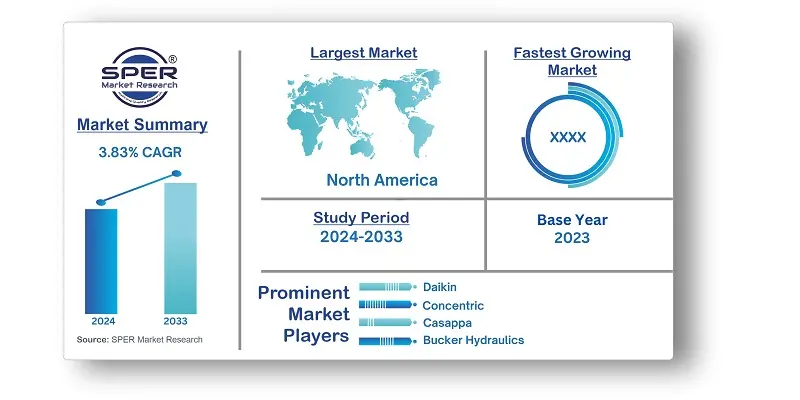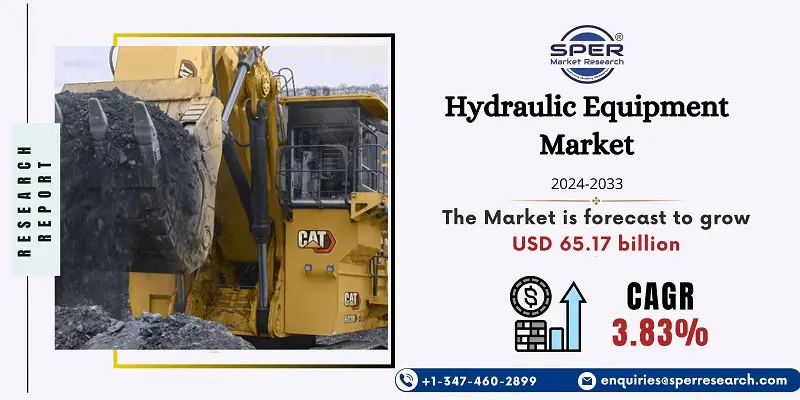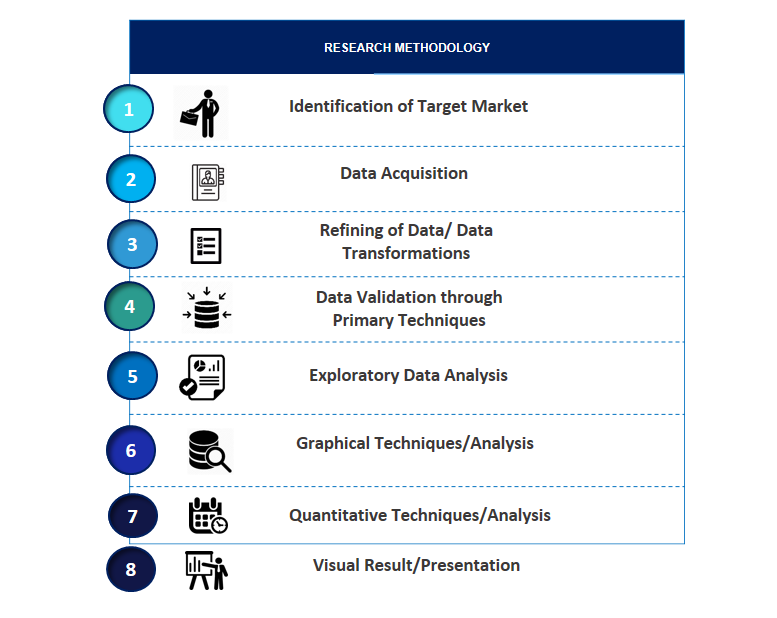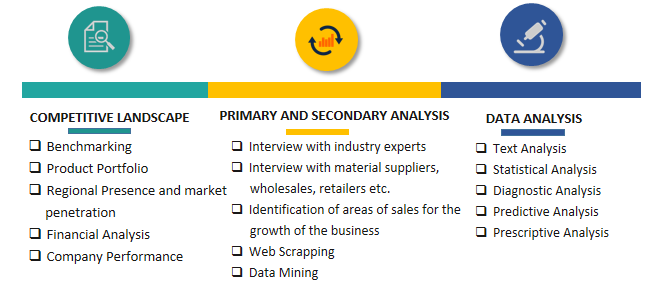
Hydraulic Equipment Market Growth, Size, Trends, Demand, Share, Revenue and Future Outlook
Hydraulic Equipment Market Size- By Application, By End User, By Product- Regional Outlook, Competitive Strategies and Segment Forecast to 2033
| Published: Apr-2024 | Report ID: MACH2413 | Pages: 1 - 238 | Formats*: |
| Category : Equipment and Machinery | |||
- January 2022; To fulfill the future's digital expectations, mobile hydraulics OEMs must create machines that are smarter, safer, and perform better than ever before. That is why, by 2022, Danfoss Sensing Solutions plans to more than treble its thin-film pressure sensor production capacity at our Minden, Germany, facility.
- April 2022; There has never been more emphasis on reducing energy use and carbon footprint, yet outcomes sometimes come at the sacrifice of usability or efficiency. The Danfoss Heat Recovery Unit provides large savings on heating bills and significant environmental benefits, all with a speedy return on investment.


| Report Metric | Details |
| Market size available for years | 2020-2033 |
| Base year considered | 2023 |
| Forecast period | 2024-2033 |
| Segments covered | By Application, By End User, By Product |
| Regions covered | North America, Asia-Pacific, Latin America, Middle East & Africa and Europe |
| Companies Covered | Kawasaki, HAWE, Hydac, Moog Inc., Bucker Hydraulics, Daikin, Concentric, Casappa, Nachi – Fujikoshi & Dantal Hydraulics. |
- End-Users
- Manufacturers of Hydraulic Equipment
- Distributors and Suppliers
- Hydraulic Fluid Manufacturers
- Government Authorities
- Consulting and Research Firms
- Venture Capitalists and Investors
- Third-Party Knowledge Providers
- Educational Institutions
- Trade Associations
| By Application |
|
| By End User |
|
| By Product |
|
- Global Hydraulic Equipment Market Size (FY’2024-FY’2033)
- Overview of Global AI-based Surgical Robots Market
- Segmentation of Global Hydraulic Equipment Market By Application (Mobile, Industries)
- Segmentation of Global Hydraulic Equipment Market By End User (Mining & Construction Agriculture & Mining, Packaging, Material Handling)
- Segmentation of Global Hydraulic Equipment Market By Product(Pumps, Motors, Valves, Cylinders, Accesorise)
- Statistical Snap of Global Hydraulic Equipment Market
- Expansion Analysis of Global Hydraulic Equipment Market
- Problems and Obstacles in Global Hydraulic Equipment Market
- Competitive Landscape in the Global Hydraulic Equipment Market
- Impact of COVID-19 and Demonetization on Global Hydraulic Equipment Market
- Details on Current Investment in Global Hydraulic Equipment Market
- Competitive Analysis of Global Hydraulic Equipment Market
- Prominent Players in the Global Hydraulic Equipment Market
- SWOT Analysis of Global Hydraulic Equipment Market
- Global Hydraulic Equipment Market Future Outlook and Projections (FY’2024-FY’2033)
- Recommendations from Analyst
1.1. Scope of the report1.2. Market segment analysis
2.1. Research data source2.1.1. Secondary Data2.1.2. Primary Data2.1.3. SPER’s internal database2.1.4. Premium insight from KOL’s2.2. Market size estimation2.2.1. Top-down and Bottom-up approach2.3. Data triangulation
4.1. Driver, Restraint, Opportunity and Challenges analysis4.1.1. Drivers4.1.2. Restraints4.1.3. Opportunities4.1.4. Challenges4.2. COVID-19 Impacts of the Global Hydraulic Equipment Market
5.1. SWOT Analysis5.1.1. Strengths5.1.2. Weaknesses5.1.3. Opportunities5.1.4. Threats5.2. PESTEL Analysis5.2.1. Political Landscape5.2.2. Economic Landscape5.2.3. Social Landscape5.2.4. Technological Landscape5.2.5. Environmental Landscape5.2.6. Legal Landscape5.3. PORTER’s Five Forces5.3.1. Bargaining power of suppliers5.3.2. Bargaining power of buyers5.3.3. Threat of Substitute5.3.4. Threat of new entrant5.3.5. Competitive rivalry5.4. Heat Map Analysis
6.1. Global Hydraulic Equipment Market Manufacturing Base Distribution, Sales Area, Product Type6.2. Mergers & Acquisitions, Partnerships, Product Launch, and Collaboration in Global Hydraulic Equipment Market
7.1. Global Hydraulic Equipment Market Value Share and Forecast, By Application, 2024-20337.2. Mobile,7.3. Industries
8.1. Global Hydraulic Equipment Market Value Share and Forecast, By End User, 2024-20338.2. Mining & Construction Agriculture & Mining8.3. Packaging8.4. Material Handling
9.1. Global Hydraulic Equipment Market Value Share and Forecast, By Product, 2024-20339.2. Pumps9.3. Motors9.4. Valves9.5. Cylinders9.6. Accessorise
10.1. Global Hydraulic Equipment Market Size and Market Share
11.1. Global Hydraulic Equipment Market Size and Market Share By End User (2020-2026)11.2. Global Hydraulic Equipment Market Size and Market Share By End User (2027-2033)
12.1. Global Hydraulic Equipment Market Size and Market Share By Application (2020-2026)12.2. Global Hydraulic Equipment Market Size and Market Share By Application (2027-2033)
13.1 Global Hydraulic Equipment Market Size and Market Share By Product (2020-2026)13.2 Global Hydraulic Equipment Market Size and Market Share By Product(2027-2033)
14.1. Global Hydraulic Equipment Market Size and Market Share By Region (2020-2026)14.2. Global Hydraulic Equipment Market Size and Market Share By Region (2027-2033)14.3. Asia-Pacific14.3.1. Australia14.3.2. China14.3.3. India14.3.4. Japan14.3.5. South Korea14.3.6. Rest of Asia-Pacific14.4. Europe14.4.1. France14.4.2. Germany14.4.3. Italy14.4.4. Spain14.4.5. United Kingdom14.4.6. Rest of Europe14.5. Middle East and Africa14.5.1. Kingdom of Saudi Arabia14.5.2. United Arab Emirates14.5.3. Rest of Middle East & Africa14.6. North America14.6.1. Canada14.6.2. Mexico14.6.3. United States14.7. Latin America14.7.1. Argentina14.7.2. Brazil14.7.3. Rest of Latin America
15.1. Kawasaki15.1.1. Company details15.1.2. Financial outlook15.1.3. Product summary15.1.4. Recent developments15.2. HAWE15.2.1. Company details15.2.2. Financial outlook15.2.3. Product summary15.2.4. Recent developments15.3. Hydac15.3.1. Company details15.3.2. Financial outlook15.3.3. Product summary15.3.4. Recent developments15.4. Moog Inc.15.4.1. Company details15.4.2. Financial outlook15.4.3. Product summary15.4.4. Recent developments15.5. Bucker Hydraulics15.5.1. Company details15.5.2. Financial outlook15.5.3. Product summary15.5.4. Recent developments15.6. Daikin15.6.1. Company details15.6.2. Financial outlook15.6.3. Product summary15.6.4. Recent developments15.7. Concentric15.7.1. Company details15.7.2. Financial outlook15.7.3. Product summary15.7.4. Recent developments15.8. Casappa15.8.1. Company details15.8.2. Financial outlook15.8.3. Product summary15.8.4. Recent developments15.9. Nachi – Fujikoshi15.9.1. Company details15.9.2. Financial outlook15.9.3. Product summary15.9.4. Recent developments15.10. Dantal Hydraulics15.10.1. Company details15.10.2. Financial outlook15.10.3. Product summary15.10.4. Recent developments15.11. Others
SPER Market Research’s methodology uses great emphasis on primary research to ensure that the market intelligence insights are up to date, reliable and accurate. Primary interviews are done with players involved in each phase of a supply chain to analyze the market forecasting. The secondary research method is used to help you fully understand how the future markets and the spending patterns look likes.
The report is based on in-depth qualitative and quantitative analysis of the Product Market. The quantitative analysis involves the application of various projection and sampling techniques. The qualitative analysis involves primary interviews, surveys, and vendor briefings. The data gathered as a result of these processes are validated through experts opinion. Our research methodology entails an ideal mixture of primary and secondary initiatives.



Frequently Asked Questions About This Report
PLACE AN ORDER
Year End Discount
Sample Report
Pre-Purchase Inquiry
NEED CUSTOMIZATION?
Request CustomizationCALL OR EMAIL US
100% Secure Payment






Related Reports
Our Global Clients
Our data-driven insights have influenced the strategy of 200+ reputed companies across the globe.




















